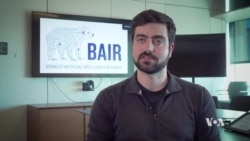ຫຸ່ນຍົນທີ່ມີຄວາມສາມາດໃນການໃຊ້ເຫດຜົນກຳລັງຈະກາຍເປັນຄວາມຈິງ ດ້ວຍຂໍ້ມູນການຝຶກອົບຮົມຈຳນວນມະຫາສານ ແລະ ຄວາມກ້າວໜ້າດ້ານປັນຍາປະດິດ. ນັກຂ່າວວີໂອເອ ແມັດ ດິບໂບລ ໄດ້ໄປຢ້ຽມຢາມຫ້ອງທົດລອງທີ່ຫຸ່ນຍົນກຳລັງຮຽນຮູ້ທີ່ຈະແກ້ໄຂບັນຫາດ້ວຍຕົວເອງ.
ພວກຫຸ່ນຍົນມີປະສິດທິພາບສູງໃນການເຮັດວຽກຢ່າງຊ້ຳແລ້ວຊ້ຳອີກ ໃນພື້ນທີ່ທີ່ຖືກຄວບຄຸມ ແຕ່ຍັງຄົງປະສົບບັນຫາໃນສະພາບແວດລ້ອມທີ່ບໍ່ສາມາດຄາດເດົາໄດ້ ເຊັ່ນໃນຫ້ອງການ ຫຼື ເຮືອນ.
ທ່ານ ຄາລ ເພີດສ໌ ຈາກມະຫາວິທະຍາໄລ ຄາລິຟໍເນຍ ເບີກລີ ກ່າວວ່າ “ມັນມີທັກສະສະເພາະຕົວ ແລະ ມັນມີທັກສະທີ່ລະອຽດອ່ອນໃນບາງແງ່ມຸມ ດັ່ງນັ້ນຫາກມີການປ່ຽນແປງໃດໆໃນສະພາບແວດລ້ອມທີ່ບໍ່ສອດຄ່ອງກັບສິ່ງທີ່ວາງແຜນໄວ້ລ່ວງໜ້າ ທັກສະເຫຼົ່ານັ້ນ ກໍມັກຈະລົ້ມແຫຼວ. ພວກເຮົາຈຳເປັນຕ້ອງມີວິທີເຮັດໃຫ້ຫຸ່ນຍົນປັບຕົວເຂົ້າກັບສະຖານະການທີ່ເກີດຂຶ້ນ ໂດຍບໍ່ຕ້ອງໃຫ້ມະນຸດຕັ້ງໂປຣແກຣມພຶດຕິກຳທຸກຢ່າງທີ່ຫຸ່ນຍົນຄວນເຮັດໄວ້ລ່ວງໜ້າ.”
ຄວາມທ້າທາຍໃນການຝຶກຫຸ່ນຍົນໃຫ້ແກ້ໄຂບັນຫາໂດຍການໃຊ້ເຫດຜົນ ແມ່ນຖືກດຳເນີນການໂດຍກຸ່ມນັກປະດິດຫຸ່ນຍົນຈາກຫ້ອງທົດລອງຊັ້ນນຳຂອງໂລກ.
ຫ້ອງທົດລອງແຫ່ງນີ້ ທີ່ມະຫາວິທະຍາໄລຄາລິຟໍເນຍ ເບີກລີ ກໍເປັນນຶ່ງໃນນັ້ນ. ລອງນຶກພາບວ່າ ເປັນໂຮງຮຽນອະນຸບານສຳລັບສອນພວກຫຸ່ນຍົນ.
ທ່ານ ວິລລຽມ ເສິນ ຈາກມະຫາວິທະຍາໄລ ຄາລິຟໍເນຍ ເບີກລີ ກ່າວວ່າ “ຂ້າພະເຈົ້າຫາກໍປ້ອນຄຳສັ່ງໃສ່ “ວາງເຫັດຢູ່ເທິງຜ້າເຊັດໜ້າ.”
ແຂນຂອງຫຸ່ນຍົນນີ້ແມ່ນກຳລັງເຮັດຕາມຄຳສັ່ງ ແລະ ໃນເວລາດຽວກັນກໍຜະລິດຂໍ້ມູນ ກ່ຽວກັບ ຂັ້ນຕອນໃນການພິຈາລະນາດ້ວຍເຫດຜົນ.
ທ່ານ ວິລລຽມ ເສິນ ກ່າວວ່າ “ກໍຄືວ່າ ມັນຫາກໍ່ລົ້ມແຫຼວໃນການຈັບເຫັດຂຶ້ນມາ ແລະ ມັນກໍຮູ້. ສະນັ້ນມັນຈະຍຶດໝັ້ນຢູ່ກັບພາລະກິດສຳຮອງເພື່ອເຂົ້າໄປຫາເຫັດ
ແລ້ວ ຈັບເອົາມັນ.”
ຖ້າມັນປະສົບຄວາມສຳເລັດ ແລະ ການໃຊ້ເຫດຜົນແມ່ນດີ, ຂໍ້ມູນນີ້ຈະສາມາດຖືກໃຊ້ເພື່ອຊ່ວຍເຫຼືອຫຸ່ນຍົນໂຕອື່ນໆ ທີ່ມີພາລະກິດຄ້າຍຄືກັນ.
ຫ້ອງທົດລອງໃນທະວີບອາເມຣິກາເໜືອ, ຢູໂຣບ ແລະ ເອເຊຍ ແມ່ນກຳລັງແລກປ່ຽນການຄວບຄຸມຂໍ້ມູນຂອງເຂົາເຈົ້າ, ເຊິ່ງ, ພ້ອມກັບຂໍ້ມູນຈາກ ອິນເຕເນັດ, ຈະຝຶກຊ້ອມ LLM ທີ່ເປັນຕົວຢ່າງພາສາຂະໜາດໃຫຍ່, ຄ້າຍຄືກັບ ChatGPT, ທີ່ແທ້ຈິງແລ້ວ ເປັນສະໝອງອັນນຶ່ງທີ່ສາມາດຄວບຄຸມຫຸ່ນຍົນໄດ້ຢ່າງກວ້າງຂວາງ.
ທ່ານ ຄາລ ເພີດສ໌ ກ່າວວ່າ “ດັ່ງນັ້ນ ໂດຍພື້ນຖານແລ້ວ ຖ້າຂ້າພະເຈົ້າສອນແຂນຫຸ່ນຍົນນຶ່ງ ວິທີຈັບເອົາກະປ໋ອງ Coke ຂຶ້ນ, ແລະຂ້ອຍມີແຂນຫຸ່ນຍົນອີກອັນນຶ່ງ ທີ່ບໍ່ເຄີຍເຫັນກະປ໋ອງ Coke ໃນຊີວິດຂອງມັນເລີຍ, ມັນກໍຈະເຂົ້າໃຈຄວາມຄິດວ່າ ກະປ໋ອງ Coke ແມ່ນຫຍັງ ໃນທັນທີ, ແລ້ວ ມັນມີໂອກາດທີ່ຈະຈັບວັດຖຸນັ້ນຂຶ້ນມາ ດ້ວຍຕົວມັນເອງຢ່າງແທ້ຈິງ.”
ການຮຽນຮູ້ວິທີລະບຸ ກະປ໋ອງ Coke ແມ່ນມາຈາກການແນມເຫັນພາບຈຳນວນຫຼວງຫຼາຍ ແລະ ຂໍ້ຄວາມທີ່ເຕົ້າໂຮມຈາກອິນເຕີເນັດ. ເຊັ່ນດຽວກັບຄວາມສາມາດໄຈ້ແຍກ ນາງ ເທເລີ ສວິຟ ຈາກຮູບພາບນັກສິລະປິນກຸ່ມນີ້.
ທ່ານ ຄາລ ເພີດສ໌ ກ່າວວ່າ “ແນວຄິດເຫຼົ່ານີ້ ສ່ວນໃຫຍ່ມັກເປັນແບບທີ່ວ່າ ເມື່ອ ກະປ໋ອງ Coke ເຕັມ ເຈົ້າຕ້ອງອອກແຮງຫຼາຍຂຶ້ນ ແລະ ຕ້ອງຍົກກະປ໋ອງໃຫ້ສູງຂຶ້ນ ຫຼືຖ້າມີຂອງແຫຼວເປື້ອນຢູ່ເທິງໂຕະໃນເຮືອນຄົວ, ເຈົ້າກໍມີແຕ່ໃຊ້ຟອງນ້ຳ ຫຼື ຜ້າເຊັດກໍພໍ. ແນວຄິດເຫຼົ່ານີ້ ສາມາດຮຽນຮູ້ໄດ້ຈາກອິນເຕີເນັດ, ເຈົ້າບໍ່ຈຳເປັນຕ້ອງຮຽນຮູ້ມັນຈາກຫຸ່ນຍົນທີ່ເຮັດສິ່ງໃດສິ່ງນຶ່ງ.”
ການຄົ້ນຄວ້າສະແດງໃຫ້ເຫັນຫຸ່ນຍົນຫຼາຍໂຕ, ສະໝອງທີ່ໄດ້ຮັບການຝຶກຊ້ອມຈາກອິນເຕີເນັດ ແມ່ນກຳລັງສະແດງຜົນງານໄດ້ດີກວ່າຫຸ່ນຍົນທີ່ທຳການຝຶກຊ້ອມດ້ວຍຕົນເອງ, ກ່າວໂດຍທ່ານ ເພີດສ໌.
ທ່ານ ຄາລ ເພີດສ ກ່າວວ່າ “ແມ່ນກະທັ້ງມີພື້ນຖານທີ່ດີທີ່ສຸດ, ຕົວຢ່າງທີ່ດີທີ່ສຸດທີ່ພວກມັນສາມາດຜະລິດ… ມັນບໍ່ໄດ້ດີເທົ່ກັບຕົວຢ່າງທີ່ພວກເຮົາສາມາດຜະລິດດ້ວຍການຝຶກຊ້ອມໃນຊຸດຂໍ້ມູນທັງໝົດທີ່ໂຮມເຂົ້າກັນ.”
ຫຸ່ນຍົນຫຼາຍໂຕມີການນຳໃຊ້ ແລະ ການອອກແບບທີ່ສະເພາະຫຼາຍ, ສະນັ້ນສະໝອງຂອງຫຸ່ນຍົນທົ່ວໄປ ແມ່ນບໍ່ໄດ້ມີຈຸດປະສົງສຳລັບມັນ. ແຕ່ທ່ານ ເພີດສ໌ ກ່າວ…
ທ່ານ ຄາລ ເພີດສ໌ ເວົ້າວ່າ “ສຳລັບແຂນຫຸ່ນຍົນທຸກໂຕ ຫຼື ຄືກັບຫຸ່ນຍົນໃນຄົວເຮືອນທຸກໂຕ ຫຼື ຫຸ່ນຍົນມະນຸດທຸກໂຕ, ໃນທີ່ສຸດແລ້ວ ຂ້າພະເຈົ້າຄິດວ່າ ໂດຍແທ້ຈິງ ເຈົ້າຈະມີຕົວຢ່າງໂຕນຶ່ງ ທີ່ເຮັດໜ້າທີ່ດັ່ງກັບຕົວຢ່າງຂັ້ນພື້ນຖານ ເພື່ອຄວບຄຸມໝົດທຸກໂຕ.”
ພວກເຮົາອາດຈະບໍ່ໄດ້ເຫັນຢູ່ໃນເຮືອນ ໃນອະນາຄົດອັນໃກ້ນີ້, ແຕ່ຫຸ່ນຍົນແມ່ນກຳລັງທຳຄວາມກ້າວໜ້າໄປຢ່າງດີຫຼາຍ.
ອ່ານລາຍງານນີ້ເປັນພາສາອັງກິດ
Robots with reasoning power are becoming a reality thanks to massive amounts of training data and breakthroughs in artificial intelligence.
Robots excel at repetitive tasks in controlled spaces but still struggle in unpredictable environments like an office or home.
"It has a specific skill, and it has a kind of brittle skill in some sense, so if anything about the environment changes ((CUTAWAY: robot reaches for Pocky, carries it to table)) that doesn't conform with what was planned for ahead of time, then these skills tend to fail. We need a way for the robot to adapt to the situation at hand without having a human pre-program every behavior that the robot is supposed to do."
The challenge of training robots to solve problems through reasoning has been taken up by a consortium of roboticists from the world's leading labs.
This lab at the University of California, Berkeley is one of them. Think of it as preschool for robots.
"I've just entered the instruction "put the mushroom on the towel."
This robot arm is following a command and at the same time generating data about its reasoning process.
"So it's just failed to pick up the mushroom, and it realizes that. So it's sticking to the sub-task to go to the mushroom and grab it."
If successful and the reasoning is sound, this data can be used to help other robots with similar tasks.
Labs in North America, Europe and Asia
are sharing their control data, which, along with data from the internet, will train an LLM, a large language model, similar to ChatGPT, essentially one brain that can control a wide variety of robots.
"So basically if I teach one robot arm how to pick up a Coke can and I have another robot arm that has never in his life seen a Coke can, it suddenly understands the concept of what a Coke can is, and it has a chance of actually picking up that object itself."
Learning how to identify a Coke can comes from vast amounts of visuals and text gathered from the internet. As does being able to pick out Taylor Swift from this lineup.
"A lot of these concepts of, when the Coke can is full you need to apply more force and you need to lift it further, or if there is a spill on the kitchen table, what you need is a sponge or a cloth to clean it up. ((CUTAWAY: Robot arm wipes table)) ((Courtesy: UC Berkeley AUTOlab)) These are concepts that you can learn from the internet. You don't need to learn them from a robot doing stuff."
Research shows the multi-robot, internet-trained brain is outperforming robots trained independently, says Pertsch.
"Even the best baseline, the best model that they could produce...
...was not as good as the model that we could produce by training on all the data sets together."
Many robots have very specialized uses and designs, so a general robot brain is not intended for them. But Pertsch says...
"For all the robot arms or like all the household robots or all the humanoid robots, ((CUTAWAY: robot waves)) eventually I think you will have essentially one model that serves as the base model to control all of them."
We may not see them in homes in the near future, but robots are making great strides forward.






ຟໍຣັມສະແດງຄວາມຄິດເຫັນ